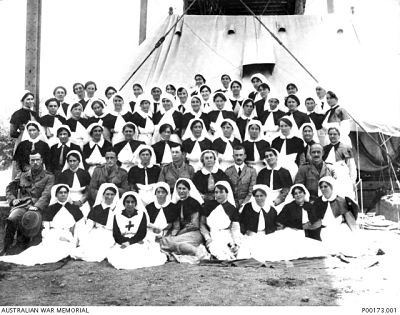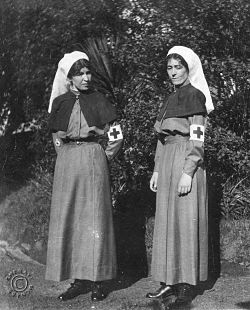WW1 Hilda Mary Steele
Hilda Steele, a nurse in World War One, was included as the only Kiwi nurse in an Australian television programme, ANZAC Girls, in 2014.
When World War One broke out in August 1914, the New Zealand Army Nursing Service had yet to be formed but by October 1914 over 400 New Zealand nurses had volunteered for service. As a result, a deputation of nurses met with the N Z Minister of Defence on New Year’s Eve and cables were sent to both the British War Office and the Australian Government offering the services of New Zealand nurses. On 25 March 1915 a cable was received from Australia asking for twelve nurses to be ready to sail on 31 March 1915.
Hilda Mary Steele of Remuera was one of these first twelve nurses selected to become part of the Australian Army Nursing Service. Hilda was born on 28th May 1887 to Malvina Florence and Thomas James Steele. Thomas was educated at London University and Heidelberg University, articled to a law firm and had come to New Zealand where he farmed at Owhio and Pipanui near Wairoa in Hawkes Bay from 1874 to 1890.
Hilda grew up in Remuera with her parents, four brothers, Oliver, Harry, Montague and Robert, and sisters Camilla and Minnie at Cricklewood in Arney Road (2nd house on the left). She passed Royal Academy music exams, won prizes for floral decorations at the Auckland Ladies Benevolent Society’s floral fete and tennis games at the Auckland Ladies Tennis Club, and helped at the St Mary’s Children’s Mission bee to raise funds. Hilda trained in nursing at Auckland Hospital from 1909 to 1912 and began private nursing at Mt Pleasant Hospital in Wakefield St in Auckland. [1]
“The chosen twelve” [1] sailed from Wellington aboard the Ulimaroa on 1 April 1915 to Sydney and then on 13 April 1915 on the hospital ship Kyarra to Egypt, disembarking at Alexandria on May 28th 1915.
In Cairo in July 1915 Hilda volunteered to start in a new infectious hospital – with an Australian sister in charge, she and others did pioneering work, in the Sultan’s Casino overlooking the Heliopolis Sporting Pavilion and later she was one of the originals to open a large Infectious Military Hospital at Choubra on the outskirts of Cairo. They remained there and at the No. 3 Australian General Hospital in Abassia until March 1916 when they embarked for France to join No. 1 Australian General Hospital.
Hilda wrote to her parents in June from the Gordon Hospital in Egypt that the New Zealanders were so delighted when they see their own nurses, plus “Some of the wounds are terrible, and yet the poor fellows make so light of them, and their one thought is to get back to the front.” She also called for the soldiers to get more benefits from the Red Cross funds as they arrived from the front with nothing having had to discard their kits in the field.The article also says – Nurse Steele states that at the Gordon Hospital the nurses are given an occasional day off duty, and are off duty from 2 p.m on alternate days. They have been splendidly entertained, and have visited many places of interest, ” but we never allow pleasure to interfere with our duties,” she adds. [2]
In France, Hilda was stationed wherever nurses were needed. She was promoted to be a Sister in April 1917 and was posted to the No. 1 Australian General Hospital in Rouen and then to the 2nd Australian Casualty Clearing Station (CCS) – these stations were literally “in the field”, near the front line. [3] It was here on her way to the 2nd CCS, that she had to stay for a short time at No.3 Australian General Hospital near Abbeville and experienced her first air raid. Shelter was in an open air slit trench, muddy, cold, uncomfortable, with not all the nurses obeying orders to vacate their ‘safe’ warm shacks. A group of WAACs lost their lives here with a direct hit on their slit trench. [4]
On the same night, during an air raid at No. 2 Australian General Hospital, Hilda was asked to stay with a sick nurse who could not be moved from her shack. Throughout the raid the two talked about their war experiences, almost oblivious to the screams of the falling bombs. They were alarmed to learn in the morning of the damage done to the hospital and the deaths in the South African hospital next door. The work was dangerous and mentally and physically very demanding.[5]
It is possible that Hilda was trained as a nurse anaesthetist in 1918/19. Several New Zealand nurses received this training as well as several members of the Australian Army Nursing Service. However, it was known that Neville Howse, Director of Medical Services, AIF, was opposed to the staffing of hospitals in the forward zone with female nurses and did not support the use of Australian nurses as anaesthetists. There is no mention in her Australian service records as being sent on such a course but it is possible as omissions were found in records of others who did complete the training. Jan Rodgers in her Ph.D. thesis in 1994 lists Hilda Steele as one of the nurses who received training in anaesthetics but her name does not appear in other such lists of nurses. [6] [7]
Hilda was posted to Nos 2 and 3 Australian General Hospitals in France throughout 1916 to 1918. In 1919 Hilda was in London with the CCS Base. She did masseuse training, the forerunner of modern physiotherapy, at the School of Massage in Great Portland St, London. She developed appendicitis and was admitted to the Royal Free Hospital in Gravesend in August 1919. She was then discharged on medical grounds and returned to Australia on the Orsova, disembarking on 6 September 1919. Hilda came off active service and onto the reserve list, carrying out territorial nursing at Narrow Neck Hospital until she transferred to the retired list in 1921, after 7 years of military nursing service.
After her discharge Hilda worked at the Evelyn Firth Soldiers Home in Parnell, Nelson as Acting Matron at Nelson College. [6] From 1929 to 1938 She worked at Auckland Hospital as the sister in charge of the Tuberculosis clinic, continuing her interest in infectious diseases, visiting TB homes and military pensioners in Auckland. These were the forerunners of the NZ community nursing service.
When WW2 broke out, she volunteered for service again but was not accepted as being over the joining age. In 1940 she opened a private guest and convalescent home called Greenacres in Titirangi Rd, caring for soldiers suffering from the effects of TB and gas. She was known for her kindness, strength and resilience, and her generosity to the sick and needy in times of post-war difficulty and poverty. [8] In 1924, Hilda married Cyril Mulcock, a farmer and they had one daughter, Berys. Hilda retired in 1962 to Selwyn Village and lived there until she died in 1972.
Hilda was not the only member of her family to serve with distinction in WW1. Her oldest brother Oliver was a professional soldier having served in the South African War and India with the Royal Berkshire Regiment. When WW1 broke out, Captain Steele was sent to France where he was killed in action on 24 October 1914 aged 32. Her brother Montague was a Second Lieutenant, serving eight months in Samoa with the original expeditionary force as a corporal of signallers, and after his return re- enlisted in the Seventh Reinforcements, gaining a commission in the Auckland Infantry Battalion. In Egypt and France he was given command of a machine gun unit. Robert Alexander Steele who was a farmer served as a sapper with the Field Engineers in Egypt when he got appendicitis and was discharged as medically unfit in 1915. Camilla Steele was a nursing sister on the N Z hospital ship Maheno to Samoa for 6 months in 1917. [9]



